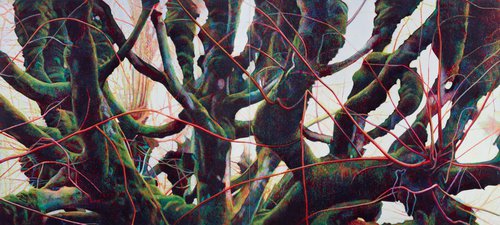-
Details
- Date
- 1994
- Media category
- Painting
- Materials used
- diptych: oil on canvas
- Dimensions
-
200.0 x 400.0 x 3.0 cm overall
:
Each part, 200 x 200 cm, each panel
- Signature & date
Not signed. Not dated.
- Credit
- Contemporary Collection Benefactors 1994
- Location
- South Building, ground level, Grand Courts
- Accession number
- 583.1994.a-b
- Copyright
- © Tim Maguire
- Artist information
-
Tim Maguire
Works in the collection
- Share
-
-
About
Tim Maguire’s paintings often refer to the art of the past and yet they are resolutely contemporary. ‘Untitled’ immediately seems familiar as its subject is the abundant, full blooms of 17th-century Dutch still-life painting. And yet the scale borders on the cinematic: the image is treated like a photographic close-up, cropped and focused on a particular detail from a colour-plate reproduction.
While the subject may be borrowed from another source, the detailing, change in scale and liquid glazes of paint bear little resemblance to the original. It does, however, still refer to the ways in which still-life painting generated meaning beyond merely reproducing objects from the world. Still-life painting in the 17th century often included a vanitas theme, which alluded to the transience of earthly life and its pleasures. Among the abundant beauty and evident wealth of natural and made things, the vanitas theme was suggested in such details as damaged and decaying nature, over-ripe fruit, and the presence of skulls and burning candles. In ‘Untitled’ a large part of the composition is taken up with yellowish brown leaves, apparently rose leaves, which have darker brown spots and edges eaten by insects, suggesting their deterioration and inevitable rot. As much as on the seductive beauty of the flowers, Maguire has focused on a historic symbol of mortality, a deliberate flaw in the perfection of the floral still life, which by extension seems to also question the artist’s vanity in displaying so much bravura technical skill. The vastly larger-than-life size scale of the flowers and leaves, and the large scale of the painting, is immersive: in viewing it we seem almost pitched into the painting to become part of its symbolic content.
Prior to his flower paintings, Maguire had painted a series of abstract paintings entitled ‘Canal’ 1992, in which a field of modulated translucent colour was sliced through with a much lighter vertical line. While inspired by the reflection of light on the Grand Union Canal in East London, they also refer to American abstractionist Barnett Newman’s famous ‘zip paintings’ in which flat fields of colour were cut through vertically with a colour suggestive of light. Maguire has also meticulously reproduced Italian artist Lucio Fontana’s slashed monochrome canvases from the 1950s and 60s. However, rather than cutting into canvases, Maguire faithfully painted an image of the canvas, the cuts and the black void behind them. In his later abstract painting ‘Untitled 98U58’ 1998 (AGNSW collection), Maguire has created a remarkably flat surface which appears almost digitally produced and yet is the result of the layering of thinly applied oil paint over which paint thinner has been poured and splashed. The rippling effect of colour and paint seems oddly liquid and like geographic strata, while the flatness adds a strangely mute quality to these potentially expressive paintings.
© Art Gallery of New South Wales Contemporary Collection Handbook, 2006
-
Exhibition history
Shown in 2 exhibitions
Flora: still life moving fast, Hazelhurst Arts Centre, , 06 Dec 2008–01 Feb 2009
FLORA AUSTRALIS, Bega Valley Regional Gallery, Bega, 11 Mar 2016–11 Jun 2016
-
Bibliography
Referenced in 4 publications
-
Tony Godfrey, Tim Maguire, 'Light, skin and beauty', pg.13-35, 2007, 21, 82-83 (colour illus.).
-
Grahame Kime., Flora: still life moving fast, 'Flora still moving fast', Gymea, 2008, (colour illus.). not paginated
-
Wayne Tunnicliffe, Contemporary: Art Gallery of New South Wales Contemporary Collection, 'Cultural memory, critical distance', pg.154-203, Sydney, 2006, 8-9 (colour illus.), 180 (colour illus.). reproduction on pgs.8-9 is a detail
-
Judith White (Editor), Look, Melbourne, Jun 2001, 10 (colour illus.).
-




